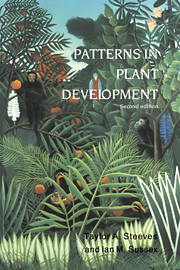Book contents
- Frontmatter
- Contents
- Preface
- Acknowledgments
- 1 Development in the vascular plants
- 2 Embryogenesis: beginnings of development
- 3 Analytical and experimental studies of embryo development
- 4 The structure of the shoot apex
- 5 Analytical studies of the shoot apex
- 6 Experimental investigations on the shoot apex
- 7 Organogenesis in the shoot: leaf origin and position
- 8 Organogenesis in the shoot: determination of leaves and branches
- 9 Organogenesis in the shoot: later stages of leaf development
- 10 Determinate shoots: thorns and flowers
- 11 The development of the shoot system
- 12 The root
- 13 Differentiation of the plant body: the origin of pattern
- 14 Differentiation of the plant body: the elaboration of pattern
- 15 Secondary growth: the vascular cambium
- 16 Secondary growth: experimental studies on the cambium
- 17 Alternative patterns of development
- Credits
- Author index
- Subject index
17 - Alternative patterns of development
Published online by Cambridge University Press: 21 December 2009
- Frontmatter
- Contents
- Preface
- Acknowledgments
- 1 Development in the vascular plants
- 2 Embryogenesis: beginnings of development
- 3 Analytical and experimental studies of embryo development
- 4 The structure of the shoot apex
- 5 Analytical studies of the shoot apex
- 6 Experimental investigations on the shoot apex
- 7 Organogenesis in the shoot: leaf origin and position
- 8 Organogenesis in the shoot: determination of leaves and branches
- 9 Organogenesis in the shoot: later stages of leaf development
- 10 Determinate shoots: thorns and flowers
- 11 The development of the shoot system
- 12 The root
- 13 Differentiation of the plant body: the origin of pattern
- 14 Differentiation of the plant body: the elaboration of pattern
- 15 Secondary growth: the vascular cambium
- 16 Secondary growth: experimental studies on the cambium
- 17 Alternative patterns of development
- Credits
- Author index
- Subject index
Summary
In the development of the plant body, one cell, the zygote, is able to express the full genetic potentialities of the organism; that is, it normally gives rise to the whole plant. All other cells express their potentialities less completely, and such expression is progressively restricted as one proceeds through the later stages of tissue and cell differentiation. Ultimately an individual cell differentiates as a highly specific entity such as a tracheid or a sieve element, which clearly expresses only a small portion of the total genetic capacity of the organism. Where differentiation brings about a drastic change in the morphology of the cell, such as the death of the protoplast in a tracheid, or the loss of the nucleus in a sieve element, no further expression of genetic potentiality is possible and differentiation is irreversible. In most cells, however, no such irrevocable loss occurs, and if differentiation is a manifestation of differential gene action rather than of mutational changes in the nucleus, reactivation of these cells by the appropriate stimuli might be expected to result in further and perhaps different expressions of their potentialities. This expectation is amply realized under many conditions, both natural and artificial, in which differentiated plant cells undergo further development and realize different and more complete expressions of their potentialities than in their original differentiation. In fact, there is today such widespread exploitation of this phenomenon in applied research, and even commercially, that its fundamental significance for the understanding of plant development may be insufficiently appreciated.
- Type
- Chapter
- Information
- Patterns in Plant Development , pp. 348 - 370Publisher: Cambridge University PressPrint publication year: 1989
- 2
- Cited by

